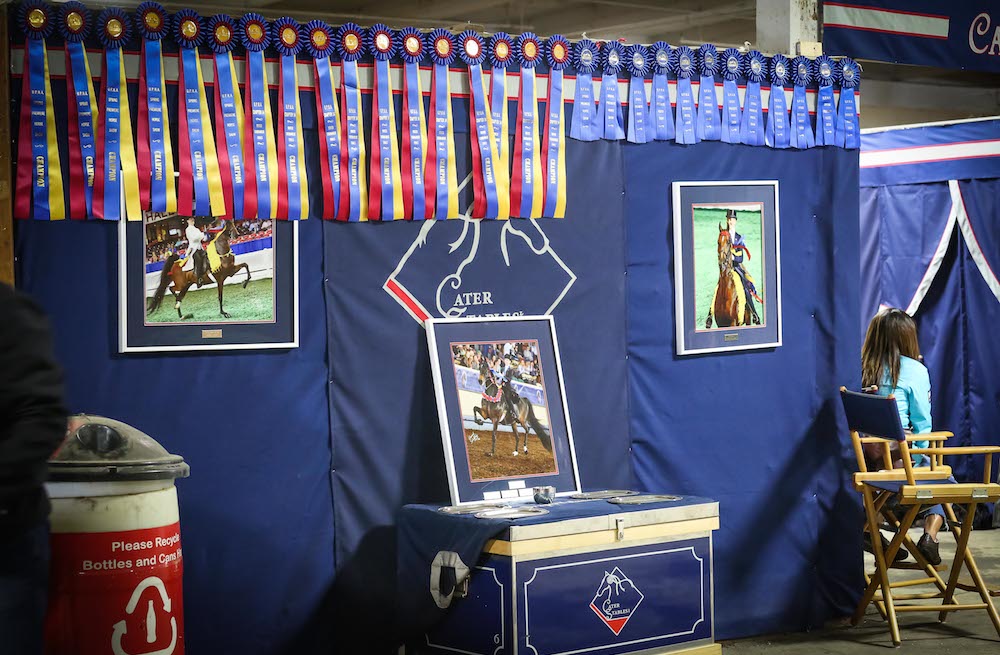 Most exhibitors probably walk into their barn’s aisle at a show, hang their suit in the dressing room, see the pictures and display racks on the curtained walls and simply don’t realize how much work has gone into creating a comfortable and inviting home-away-from-home for the barn and its clients.
Most exhibitors probably walk into their barn’s aisle at a show, hang their suit in the dressing room, see the pictures and display racks on the curtained walls and simply don’t realize how much work has gone into creating a comfortable and inviting home-away-from-home for the barn and its clients.
As anyone who has helped to set up before a show knows, there is no magic elf that comes in and does the work. Everything – from the dressing room to the tack room and hospitality area – was created with a lot of sweat, elbow grease, some screws and maybe a few tears from dedicated staff and helpers. This creative and precise process is all about the details.
The basics
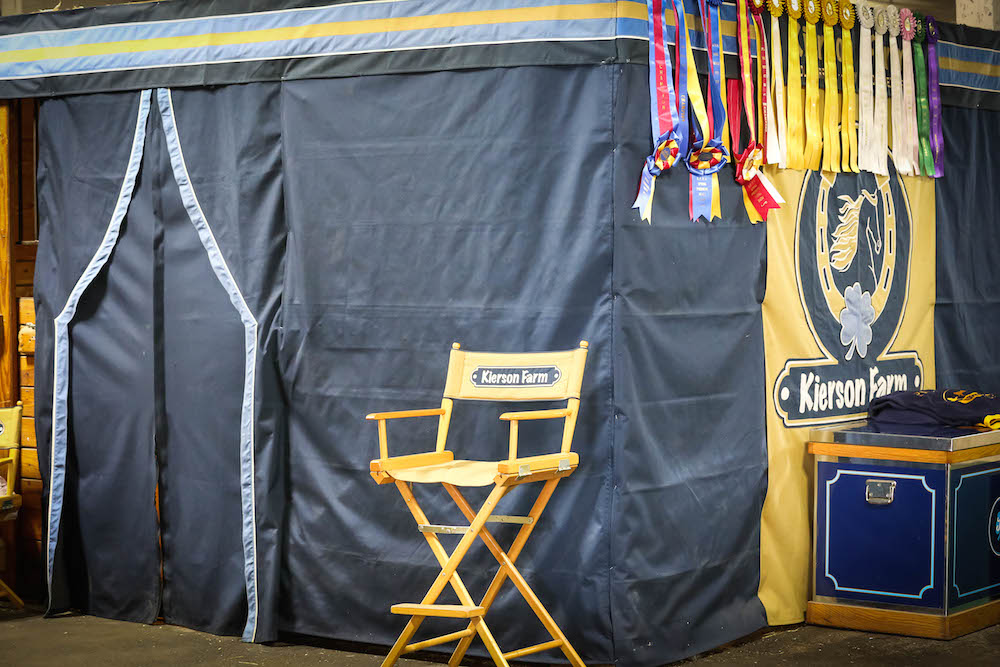 Drapes and tack trunks are the main components to a professional stabling area. Many farms, including Taylor River Farm, Northgate Stables, High Tail Acres, Verrill Stables and Luman Wadhams Stables purchase their custom drapes and trunks from RaDon Inc., or Appointments USA.
Drapes and tack trunks are the main components to a professional stabling area. Many farms, including Taylor River Farm, Northgate Stables, High Tail Acres, Verrill Stables and Luman Wadhams Stables purchase their custom drapes and trunks from RaDon Inc., or Appointments USA.
Nearly every barn will use large drapes to cover the front of the aisles and the dressing rooms, show and work tack areas and hospitality stalls. These coverings are not just for cosmetic purposes to cover up unsightly stained wood; they also help create an inviting and professional appearance. Zippered doors for tack areas and dressing rooms create a private area for clients to change into their show clothes and help keep busy work areas from being an eyesore.
Hanging these drapes is usually the most time-consuming part of the set-up process. If the facility has wooden stall fronts, it makes the chore of stapling the drapes up much easier. But if you happen to be assigned temporary stalls, a framework needs to be built first, to provide a secure surface for stapling. 1”x3” boards are strong enough to build the frame, but easy to bundle and carry. Best of all, you can use them at shows throughout the year to help keep costs down.
When hanging drapes, it is important to utilize a proper technique. After spending thousands of dollars on the material, there is nothing worse than having it look saggy or wrinkly.
“Because of my OCD, I hang every drape myself,” said Kristen Cater of Cater Stables. “I try to get them as tight as I can, because nothing drives me more crazy than when it rains and my drapes sag.”
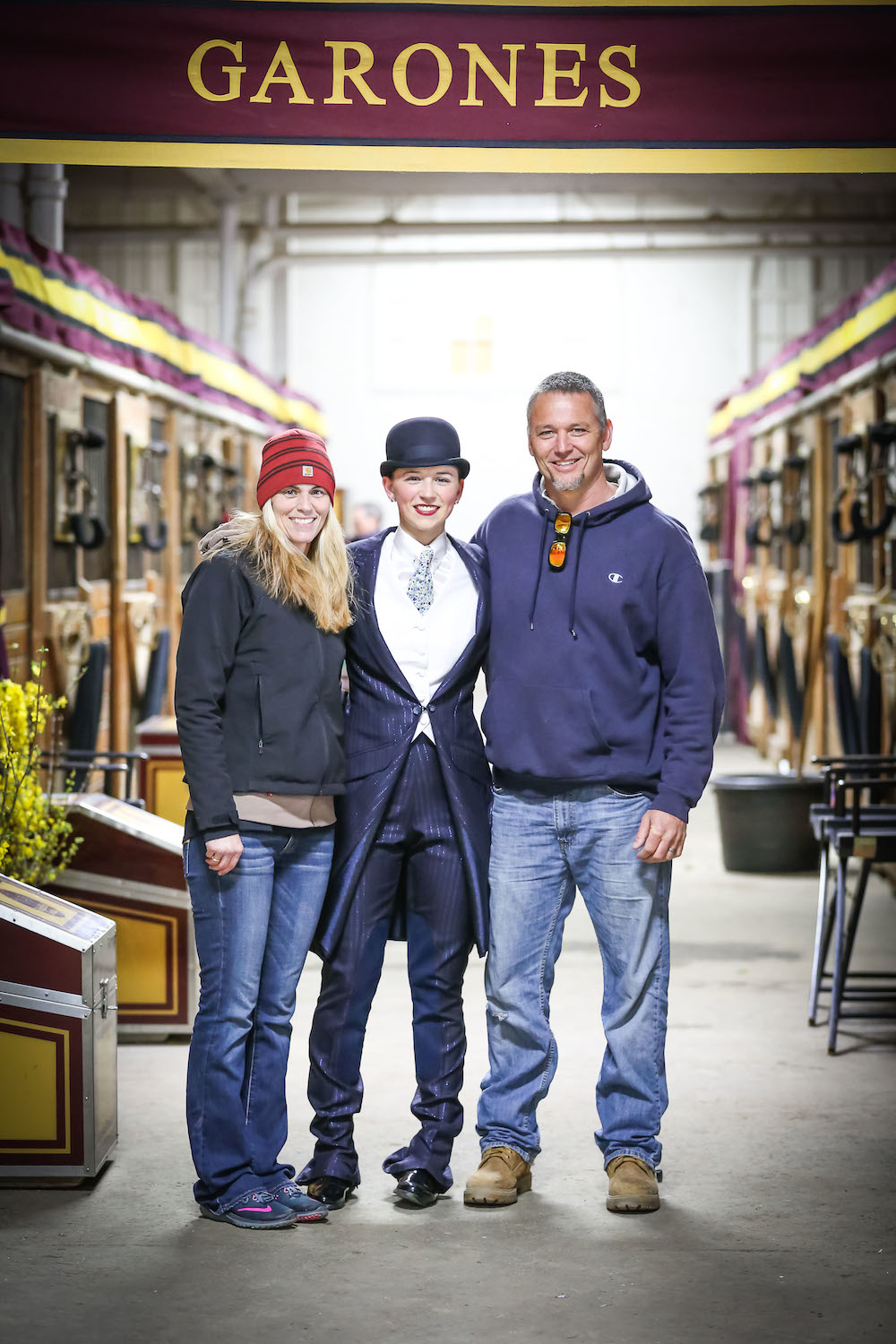
To help decrease the amount of wrinkling, it is important to carefully fold the drapes before storing them. Kristen recommends folding them inside out.
“I think this helps with the drapes being flat without fold marks when they hang,” she said.
However, if a few creases are visible, the material has just enough stretch in it that if you pull it tight (really tight!) as you’re stapling, the creases from folding will usually come right out.
In addition to these normal drapes, valances running down the aisle at the top of the stalls are a good way to hide conduit and ugly electrical outlets, while maintaining a sense of uniformity for each stable. Though it is a little extra work, farms like Fairfield South will add some boards to the top of the stalls to raise the barn’s banner, allowing enough room for horses to safely pass under.
Another obstacle that has to be tackled is the presence of dust. When you combine sawdust, dirt arenas and lots of hay, dust on every surface is impossible to avoid. For Heather Boodey of Ingleside Farm, plastic is the answer.
“I hang plastic in all of our dressing rooms, tack rooms and our hospitality room,” she said. “That is my least favorite job.”
The flimsy plastic tears easily when you’re trying to put it up, and the pieces never seem to be big enough to stretch across stalls, but the end result is a greatly reduced amount of dust clinging to your suit, saddle or snack.
Decorations
Once the big stuff is done, it’s time to get creative with the decorations. Every farm has its own traditions when it comes to accessories. Some keep it simple with a small flower display, while others go all out with huge themed build-outs. A lot of this depends on the length and prestige of the show. It would not be smart to spend two days building a massive structure for a local two-day show, but if it was a week-long one like Louisville, Kansas City, or Oklahoma, the effort would be well worth it, and much appreciated by the clients.
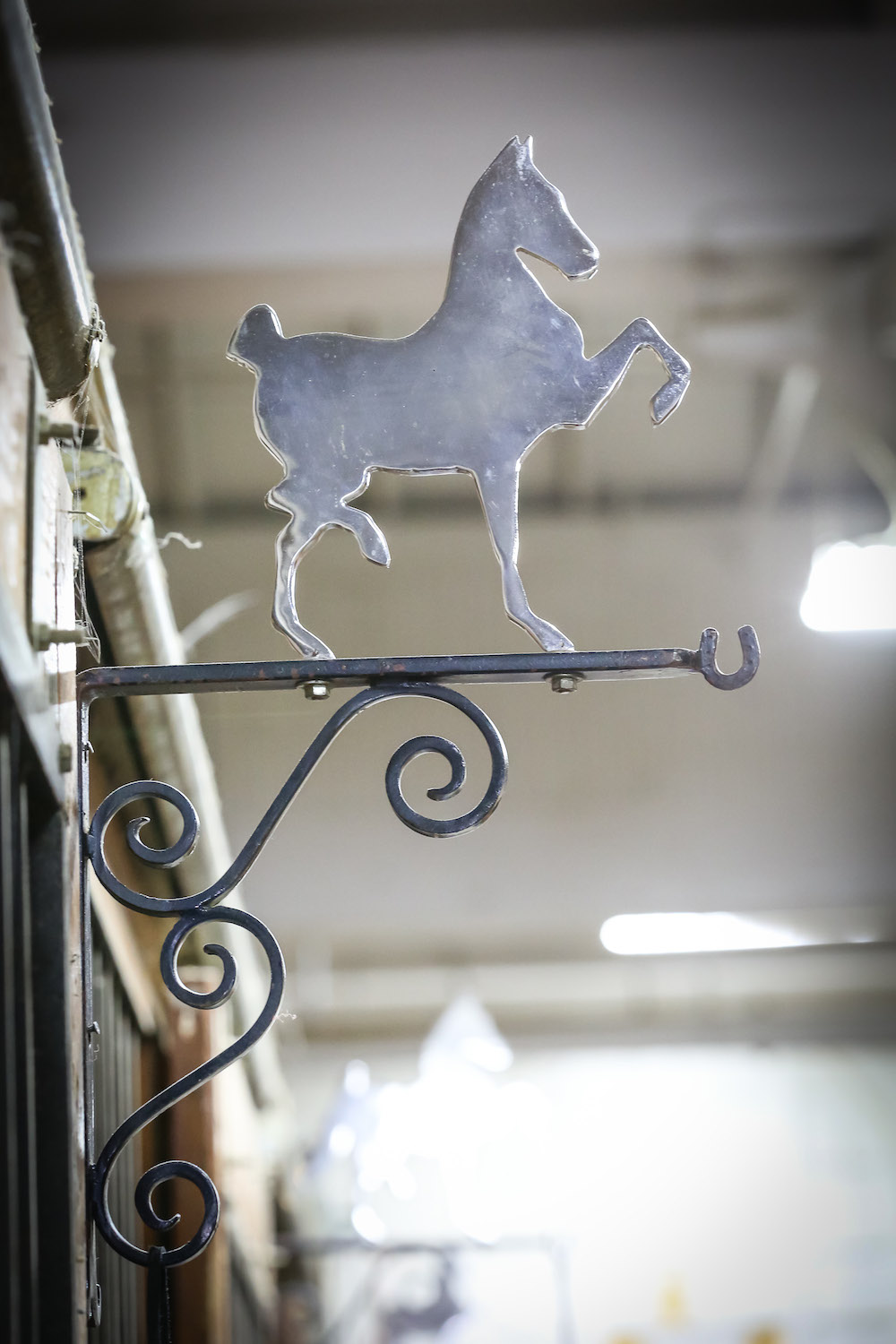
Hanging pictures is one way to dress up a stall front display, something that Kristen utilizes often.
“Normally, we would try and bring any large picture we have of the horses or riders/drivers that are competing at that show,” she said.
However, while the large pictures help to show off impressive wins for a barn, the weight of those framed images can make it difficult to safely hang.
“I worry the [temporary] stalls aren’t strong enough and the photos might fall and break, so we don’t bring them to every show,” she said.
While Kristen loves her current display, she tries to add a little something to it each year.
“A few years ago we added the rug,” she said. “Last year we added the cooler rack with our logo on it. I'm not sure what we will add this year but hopefully something! I would love to get a custom mirror.”
The decorations don’t have to stop at the front of the aisle, either. There are various ways to dress up the front of each horse’s stall. Some farms use a small square piece of drapery with the farm logo on the solid piece of the stall door, while others use a dressy towel bar. From two silver or gold nails to welded horse shoes, finding a creative way to hang halters neatly can also help to create a sense of exclusivity.
One last small item to consider is a type of rack or basket for storing the many industry publications (like Saddle & Bridle) that are passed out at horse shows. Laying them on trunks can be bothersome, as they always seem to be in the wrong place when someone needs to get an item out of the trunk. It’s messy, and the magazines end up tattered, torn, or covered up. Look for some old piece at an antique store or a shiny new one from a department store; High Tail Acres uses a simple basket to keep theirs neatly stored and available for clients during breaks in showing.
Landscaping
Flowers, shrubbery and mulch can really help to increase the curb appeal of a barn’s stall front. Hanging baskets of flowers or potted shrubbery can last all summer if cared for properly in-between shows, which not only helps to reduce costs, but also means less time trying to figure out what to do to spruce up the stalls. For those who don’t have a green thumb at all, fake plants have become more realistic looking, and will last forever if they don't end up on the bottom of a pile of blankets and feedbags on the equipment trailer.
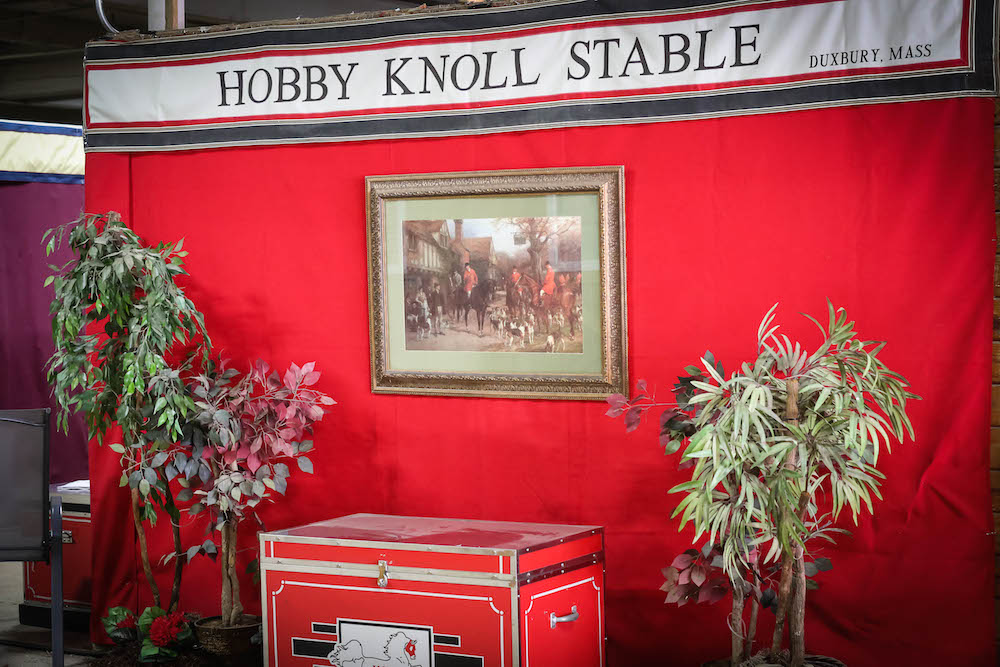
At some of the bigger shows, like Louisville, companies and individuals even offer landscaping and stall front set ups. What better way for the trainers and grooms to arrive at a show after a long journey, then to have those tasks already completed.
Hospitality
Hospitality areas can be a challenge no matter how big a barn is or how many clients it has.
Some barns take care of everything, but for others it’s a group effort. At Cater Stables, Kristen enlists the help of Traci Bridges for their food and beverage area.
“She’s the best,” Kristen said. “We have a lot of clients that also offer to pick up food, bring treats, or bring drinks for everyone.”
Not everyone has time to go out to lunch or even take a break to run to the food truck, so having plenty of grab-n-go snacks available will help to keep clients and staff happy.
When it comes to seating, custom director’s chairs work well enough for shorter shows, but clients at longer and larger shows appreciate a dedicated seating area with a TV for watching the live stream. It’s probably safe to say that storing and transporting full-size couches and refrigerators for use at horse shows is not on the top of most horse trainer or grooms’ bucket lists; in addition to the difficulty in moving these large items, the chance of them getting damaged, scratched or eaten by mice is a very real concern. However, there are other options.
Though many never think of it, it is possible to rent those items and more from companies like Rent-A-Center. They offer very reasonably priced weekly rental periods, and oftentimes free delivery and pick up.
Tearing down
After the effort of set up and the exhaustion of a long horse show, many trainers and staff want to tear down as quickly and easily as possible and head home. However, this is a surefire way to jeopardize their expensive equipment.
The Ingleside set up is proof that, if properly cared for, drapes, tack trunks, display racks and similar items can last a long time.
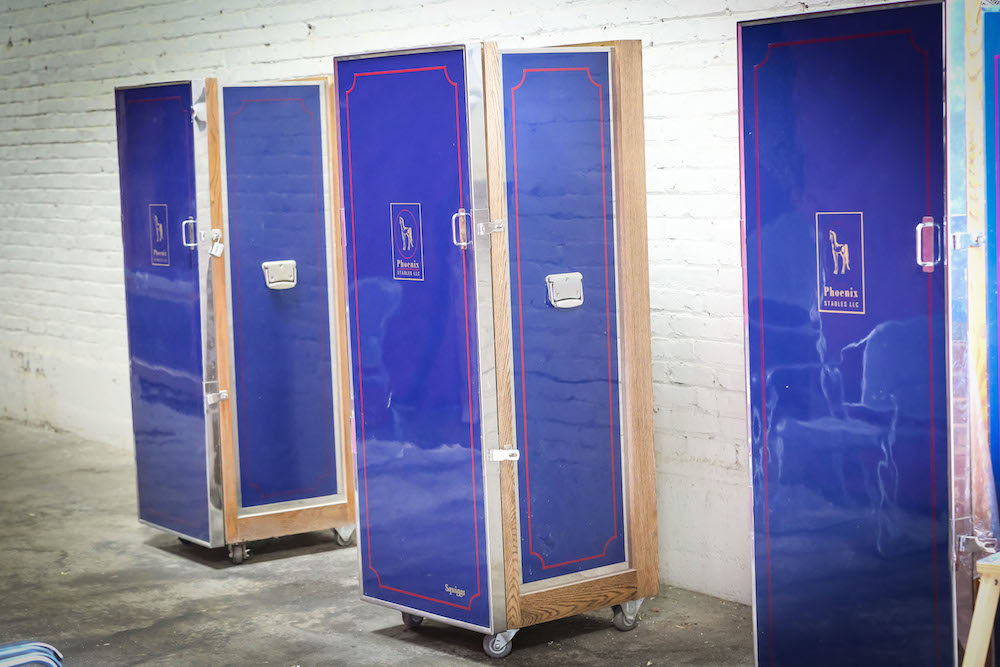
“My parents purchased a lot of our stall fronts, trunks, etc. in the late 80s,” Heather said.
In between shows, she stores her drapes in large Rubbermaid containers. The totes are convenient because the boxes stack nicely and labels can be attached and changed easily to mark what is in each container. And, of course, they close securely to keep the drapes clean in-between shows – something that is extra important to Heather.
“They get washed and refolded after every show, unless it’s a super clean facility,” she said.
One of the leading reasons for the purchase of new stall drapes is a harsh tear down process. While the “rip and remove” method is fast, it runs a greater risk of damaging the drapes. Those who opt for this method can use shorter staples, which don’t go as far into the wood and thus rip with less effort, but the safest method involves using a screwdriver or needle nosed pliers to remove each and every staple. Many barns, even Ingleside, employ a mix of both methods.
“We try to pull staples out when we can, but that’s only about 1/3 of the time,” Heather said.
These compromises are just part of the challenge in creating and maintaining a proper horse show stabling area – something that should be clean, functional and welcoming, but doesn’t have to be elaborate, or even new. In fact, sometimes unique and sentimental is the way to go.
“Our sign was made by Jennifer Joiner and given to my parents by some wonderful clients, the Daniels,” Heather said. “I think of them every time I hang it.”



